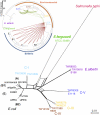Genome sequencing of environmental Escherichia coli expands understanding of the ecology and speciation of the model bacterial species
- PMID: 21482770
- PMCID: PMC3084108
- DOI: 10.1073/pnas.1015622108
Genome sequencing of environmental Escherichia coli expands understanding of the ecology and speciation of the model bacterial species
Abstract
Defining bacterial species remains a challenging problem even for the model bacterium Escherichia coli and has major practical consequences for reliable diagnosis of infectious disease agents and regulations for transport and possession of organisms of economic importance. E. coli traditionally is thought to live within the gastrointestinal tract of humans and other warm-blooded animals and not to survive for extended periods outside its host; this understanding is the basis for its widespread use as a fecal contamination indicator. Here, we report the genome sequences of nine environmentally adapted strains that are phenotypically and taxonomically indistinguishable from typical E. coli (commensal or pathogenic). We find, however, that the commensal genomes encode for more functions that are important for fitness in the human gut, do not exchange genetic material with their environmental counterparts, and hence do not evolve according to the recently proposed fragmented speciation model. These findings are consistent with a more stringent and ecologic definition for bacterial species than the current definition and provide means to start replacing traditional approaches of defining distinctive phenotypes for new species with omics-based procedures. They also have important implications for reliable diagnosis and regulation of pathogenic E. coli and for the coliform cell-counting test.
Conflict of interest statement
The authors declare no conflict of interest.
Figures



References
-
- Stackebrandt E, et al. Report of the ad hoc committee for the re-evaluation of the species definition in bacteriology. Int J Syst Evol Microbiol. 2002;52:1043–1047. - PubMed
-
- Rosselló-Mora R, Amann R. The species concept for prokaryotes. FEMS Microbiol Rev. 2001;25:39–67. - PubMed
-
- Gevers D, et al. Opinion: Re-evaluating prokaryotic species. Nat Rev Microbiol. 2005;3:733–739. - PubMed
Publication types
MeSH terms
Grants and funding
LinkOut - more resources
Full Text Sources
Other Literature Sources
Molecular Biology Databases

